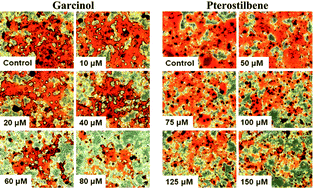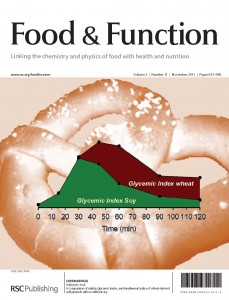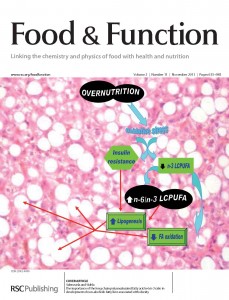This month sees the following articles in Food & Function that are in the top ten most accessed:-
Review of the efficacy of green tea, isoflavones and aloe vera supplements based on randomised controlled trials
Gary Williamson, Patrick Coppens, Lluís Serra-Majem and Tristan Dew
Food Funct., 2011, Advance Article, DOI: 10.1039/C1FO10101C
The immediate and short-term chemosensory impacts of coffee and caffeine on cardiovascular activity
Michael K. McMullen, Julie M. Whitehouse, Gillian Shine, Peter A. Whitton and Anthony Towell
Food Funct., 2011, 2, 547-554, DOI: 10.1039/C1FO10102A
Mechanisms of action of isothiocyanates in cancer chemoprevention: an update
Sandi L. Navarro, Fei Li and Johanna W. Lampe
Food Funct., 2011, 2, 579-587, DOI: 10.1039/C1FO10114E
Development of oral food-grade delivery systems: Current knowledge and future challenges
Revital Cohen Benshitrit, Carmit Shani Levi, Sharon Levi Tal, Eyal Shimoni and Uri Lesmes
Food Funct., 2011, Advance Article, DOI: 10.1039/C1FO10068H
Transcription profiles of LPS-stimulated THP-1 monocytes and macrophages: a tool to study inflammation modulating effects of food-derived compounds
Wasaporn Chanput, Jurriaan Mes, Robert A. M. Vreeburg, Huub F. J. Savelkoul and Harry J. Wichers
Food Funct., 2010, 1, 254-261, DOI: 10.1039/C0FO00113A
Review of in vitro digestion models for rapid screening of emulsion-based systems
David Julian McClements and Yan Li
Food Funct., 2010, 1, 32-59, DOI: 10.1039/C0FO00111B
Binding of citrus flavanones and their glucuronides and chalcones to human serum albumin
ammad Kamran Khan, Njara Rakotomanomana, Claire Dufour and Olivier Dangles
Food Funct., 2011, 2, 617-626, DOI: 10.1039/C1FO10077G
Botanical species being used for manufacturing plant food supplements (PFS) and related products in the EU member states and selected third countries
Chlodwig Franz, Remigius Chizzola, Johannes Novak and Silvia Sponza
Food Funct., 2011, Advance Article, DOI: 10.1039/C1FO10130G
The importance of the long-chain polyunsaturated fatty acid n-6/n-3 ratio in development of non-alcoholic fatty liver associated with obesity
Rodrigo Valenzuela and Luis A. Videla
Food Funct., 2011, 2, 644-648, DOI: 10.1039/C1FO10133A
Safety assessment of plant food supplements (PFS)
Suzanne J. P. L. van den Berg, Lluis Serra-Majem, Patrick Coppens and Ivonne M. C. M. Rietjens
Food Funct., 2011, Advance Article, DOI: 10.1039/C1FO10067J
Why not take a look at the articles today and blog your thoughts and comments below.
Fancy submitting an article to Food & Function? Then why not submit to us today or alternatively email us your suggestions.
 Read the full issue on Plant Food Supplements online here.
Read the full issue on Plant Food Supplements online here. 















